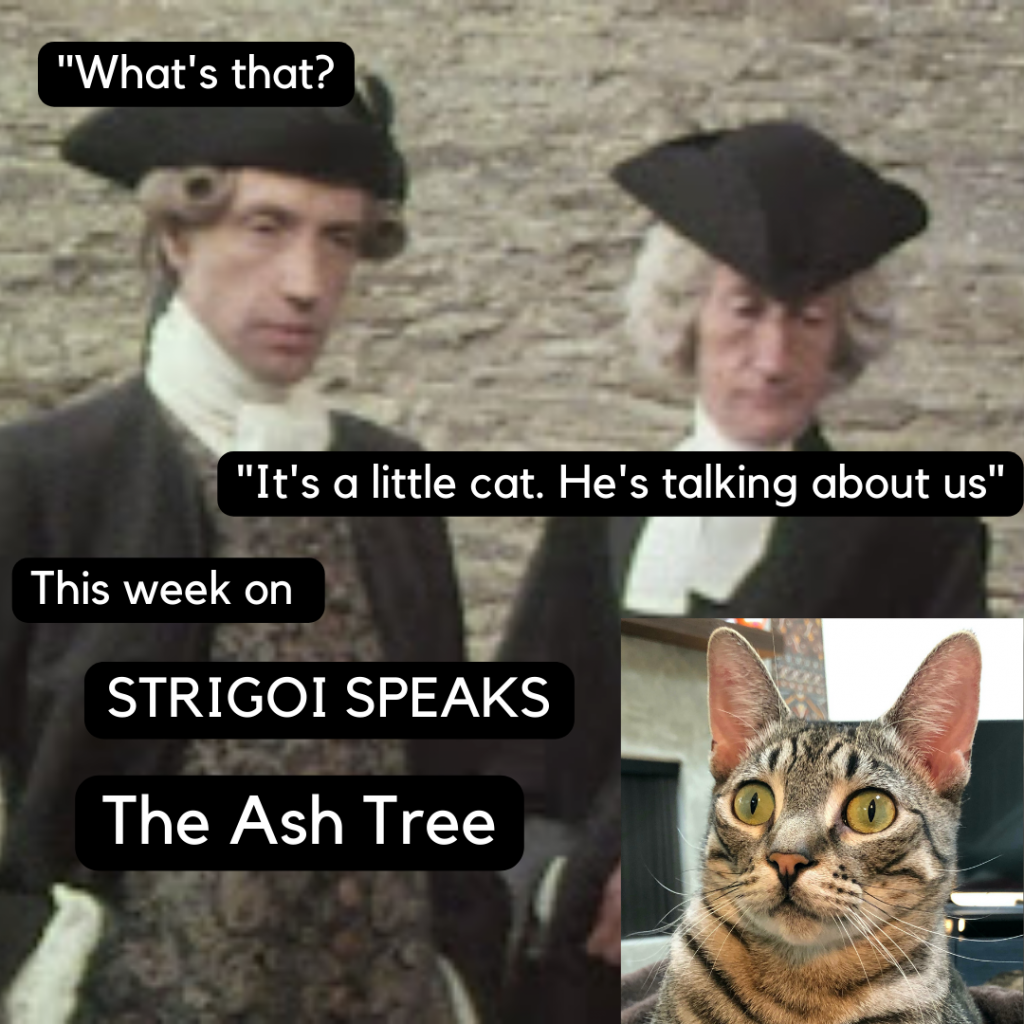
To watch The Ash Tree, click here
This week, I will continue my discussion of the BBC’s Christmas ghost stories by considering their adaptation of M.R. James’ “The Ash-Tree.” Not so much a ghost story as a work of folk horror, “The Ash Tree” (1975) stages what are now classic conflicts between the outsider and the native, the town and the country, the Christian and the Pagan. It stands out in the genre because of its elegant depiction of non-linear time and its participation in different–even clashing–aesthetic registers. It’s also distinctive because of Barbara Ewing and her stunning performance as Mistress Mothersole. If you like Witchfinder General (1968) and The Blood on Satan’s Claw (1971), then this short film is for you.
“The Ash Tree” is about an intergenerational curse. Sir Richard Fell inherits an estate from his bachelor uncle, who, in turn, inherited it from his bachelor uncle, Sir Matthew. In the 17th century, Sir Matthew accused a local woman, Mistress Anne Mothersole, of witchcraft, a charge that led to her execution. On the gallows, she shouted “mine shall inherit” to an astonished crowd; and soon after her hanging, Sir Matthew was found dead in his bed, his skin strangely blackened. Sir Richard tries to ignore this gruesome history by focusing on the future: his upcoming marriage to Lady Augusta and his designs for an Italianate renovation of the manor. However, try as he might, he cannot escape the past.
In almost all narratives, the past impinges to varying degrees on the present, and film has developed its own vocabulary for representing history’s continuing impact. “The Ash Tree” is particularly good at this. Instead of sharp cuts to the 17th century at sensitive moments in the story line, the film’s flashbacks occur as Sir Richard goes about his everyday affairs, writing a letter, walking through the woods, conversing with his architect, etc. As he engages in these mundane activities, we hear chirring, whispering, or crying–sounds with no obvious referent in the past or present–and suddenly he is acting as his Uncle Matthew, answering questions from petitioning tenants, greeting Mothersole along a woodland path, and meeting the witch-finder general. If ordinary tasks trigger these trips to the past, so, too, do seemingly insignificant visual cues. Sir Richard isn’t transported by the sight of Mistress Mothersole’s tombstone–an obviously meaningful material object that might–in a more heavy-handed film–trigger thoughts of the witch trial. Instead, he is inexplicably moved by his desk drawer. On opening it, the scene shifts to a torture chamber where he–now inhabiting the role of Sir Matthew–explains his accusation to Mistress Mothersole, whose naked and bleeding body is tethered to a stake. Both the drawer and the dungeon are dark places where men keep their possessions and, while this connection is tenuous, it is also unexpected and strangely poetic. Occasioned by loose association or sometimes by nothing at all, the film’s frequent yet subtle temporal slippages create a sense that the past is coterminous with the present, an impression that is strengthened by the casting. With the same actor playing both nephew and uncle, I often didn’t know what century I was in. Kinda like Richard and many other characters of in the folk horror genre who feel lost in time.
Moving between different centuries, “The Ash Tree” also shifts between aesthetic and narrative modes. It’s like two films in one. At first, I thought it was an elevated meditation on the status of testimony and the (un)reliability of human perceptions. Sir Matthew claims that, while he doesn’t want to be instrumental in the death of Mistress Mothersole, he is compelled to speak the truth of what he has witnessed: Awakened in the middle of the night by singing and the sound of breaking branches, he saw Mothersole beneath the ash tree outside of his bedroom window conducting some unspecified witchy business. He is fixated on the evidence of his senses and repeatedly states “I have seen what I have seen.” Yet instead of underscoring his conviction, Sir Matthew’s obsessive insistence on the truth underlying his sensations suggests that he is struggling with doubt. After all, the scene has all the marks of a dream. Sensing equivocation in his certainty, I looked forward to the slow unraveling of Matthew’s mind under the weight of guilt and anticipated the consequences, real or imagined–this point is ambiguous in “serious” horror–of inherited sin on Richard’s generation. Maybe his betrothed, Lady Augusta, who’s always in the saddle, would fall from her horse and die; or Richard, plagued by hallucinations, would suffer a psychotic break that would unfit him for marriage. Through one or both of these sad though not extraordinary events, I expected his reproductive life and thus the Fell family line to end; and the ultimate cause of all this adversity would be deliciously inconclusive–either Mothersole’s curse or plain bad luck, you decide.
But this is no psychological thriller. Mothersole’s threat to the Fell family isn’t fulfilled through mundane misfortunes–terrible accidents that are attributable to natural causes–but instead through her own fantastical offspring, spider-like creatures with fuzzy baby heads and haunting cries. In delivering on her promise, “The Ash Tree” suddenly shifts from a relatively quiet and realistic film to a brazen creature feature. I laughed at the practical effects, not because of their quality–in fact, they are quite good–but because I wasn’t expecting them. Still, despite the jolt and a little bit of gear grinding, I enjoyed the ride.
If not for the witchcraft and spiders, watch “The Ash Tree” for Barbara Ewing’s inspiring performance as Mistress Mothersole. Bare breasted and strapped to a pole, she exhibits neither fear nor embarrassment, but instead silently smolders with rage and contempt. She returns Sir Matthew’s stare with such dignity and defiance that I purpled in shame on his behalf. It’s an incredible moment and unlike anything I’ve ever seen before.